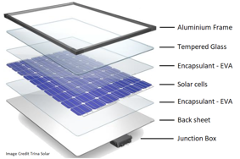
Like most inventions, solar panels were created to solve a problem. In the 1950s, scientists took note of a large lift in home electricity usage and started to experiment with technology that would utilize the energy from the sun. They believed that this innovative technology could replace the increasing number of inefficient power plants. With that problem in mind, the world’s first silicon photovoltaic cell was created in 1954 and began a new scientific era of renewable energy. Although these cells, and eventually the first panels, were very inefficient, decades of development have allowed solar panels to become a viable and cheaper alternative to power plant electricity. Because Americans care so much about price tags, solar panels are marketed as “huge” money savers for all homeowners, but do they really make a positive impact on the environment?

First things first, how are solar panels made?
The first step to understanding the overall environmental impact or carbon footprint of a product is to look at how it is made. Solar panels create energy when light from the sun enters the panel’s array of silicon cells and knocks electrons. In order to create a solar panel, a factory requires large quantities of silicon. The best way to extract silicon in its raw form is through exposing quartz sand to extremely high heat. From this purified sand, silicon is extracted and then transformed, through a multi-step process, into solar cells. While the rest of the multi-step manufacturing process is rather eco-friendly, this first step requires fossil fuels to heat quartz sand up to temperatures higher than 2000 degrees Celsius. Luckily, the overall greenhouse gas emission given off by this first step does not come anywhere close to the amount of greenhouse gas emissions eliminated through the life of the solar panel. To make matters even better, solar panel companies are investing millions in artificial intelligence, which is helping develop new manufacturing processes that will utilize clean chemical reactions to extract silicon from raw materials. Hopefully in the coming years, solar panel factories will no longer require large, fossil fuel burning arc furnaces, allowing for a cleaner manufacturing process and an even smaller carbon footprint.

What about panel transportation?
Panels are manufactured all over the world, and many panels that are installed in the US, are manufactured in the US (regardless of the country the company was founded in). This allows foreign companies to avoid US tariffs and keep costs low for US consumers. Solar power buyers can appreciate that the initial carbon footprint associated with the manufacturing and shipment process will be quickly offset by the clean energy produced by the solar system!
Once the panels are running how do they impact the environment?
Now that we have looked at some of the environmental consequences of solar panels, let’s see how they can positively impact our surroundings. Once a panel is installed on a residential roof, it begins to produce clean electricity. Clean electricity requires no fossil fuels, which means that it gives off no emissions of greenhouse gases. Over the typical 25-year life span of a solar system, the average American household uses about 180,000 kilowatts of electricity. In order to produce this massive amount of energy, power plants utilize coal to heat water to high temperatures, which turns a generator and produces electricity. In order to provide 180,000 kilowatts of electricity, a power plant will burn about 80 tons of coal. This means that just one residential solar system will offset 80 tons of coal or 175 tons of carbon dioxide in its lifetime. To put this in perspective, the emissions eliminated by a solar system is also equivalent to planting 4000 trees or taking two cars off the streets that would have driven 200,000 miles each!
While these environmental benefits are commonly known, many homeowners do not realize that going solar is a great way to reduce their overall water usage as well. Power plants not only require coal that causes poor local air quality, but they also use millions of gallons of water to produce power and cool down factory generators and machines. By going solar, the typical American will decrease their overall water usage by 4 million gallons. These huge savings will allow local ecosystems that have been stripped of water to rebuild and hopefully return to a state where both animals and plants can flourish.

All in all, solar is a fantastic way to make a positive impact on the environment. As more homeowners make the switch to clean and renewable solar energy, humanity will rely less on fossil-fuel produced electricity and solar will become more affordable. This will cause a surge in solar panels, which will benefit local ecosystems, clean the air, and reduce climate change. Unfortunately, many homeowners still get lost in number crunching and forget that the environmental benefits of solar should play a large part in their overall purchasing decision.
What happens to old solar panels?
With so much focus on increasing efficiency, many of the early solar panel scientists neglected to think about what would happen to solar panels once their life span was up. In the last decade, many of the original solar panels have stopped producing energy and have become waste. Sadly, the majority of these “dead” panels have been tossed into landfills where they will sit for tens of thousands of years before they start decomposing. Although most panels could be recycled, it is not cost effective, meaning that solar owners are better off throwing old panels in the trash. This unfortunate truth has led to the development of new, more cost-effective recyclable panels. Scientists are focusing on making solar panel technology that will allow the majority of the “dead” panel to be reused after its full lifespan. Not only could this save solar companies 15 billion dollars by 2050, but it would greatly reduce solar panel waste and landfill usage. All in all, billions of dollars are being invested in solar panel tech, meaning recyclable panels aren’t just a great idea, but soon to be a reality.

Blue Raven Solar Promotes Clean Energy
At Blue Raven Solar, we pride ourselves on providing clean renewable energy to tens of thousands of Americans across the nation. Along with helping our customers impact the environment, Blue Raven has developed a partnership with GivePower. The Givepower GivePartner foundation builds solar-powered desalination water farms. These farms produce up to 70,000 liters of clean water for communities in areas that do not have access to clean water. With every Blue Raven installation, we give $20 to GivePartner, and that $20 donation provides one person with access to clean water for at least 20 years. If you’d like to learn more about how Blue Raven Solar promotes clean energy, click on the links below:
Givepower GivePartner Partnership
Sources:
https://energypost.eu/solar-energy-is-green-solar-panels-are-not-ai-can-revolutionise-their-design/


Sorry, the comment form is closed at this time.